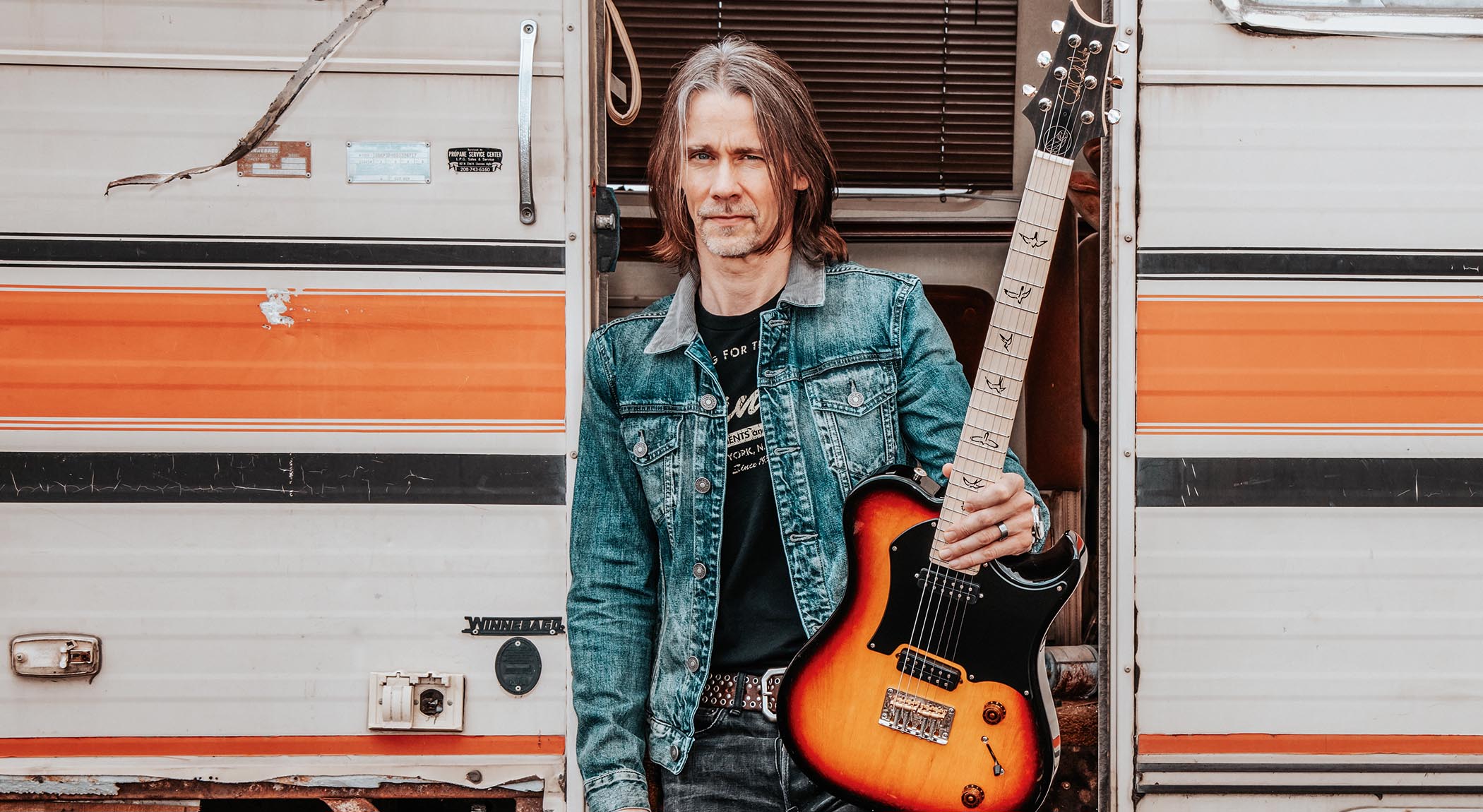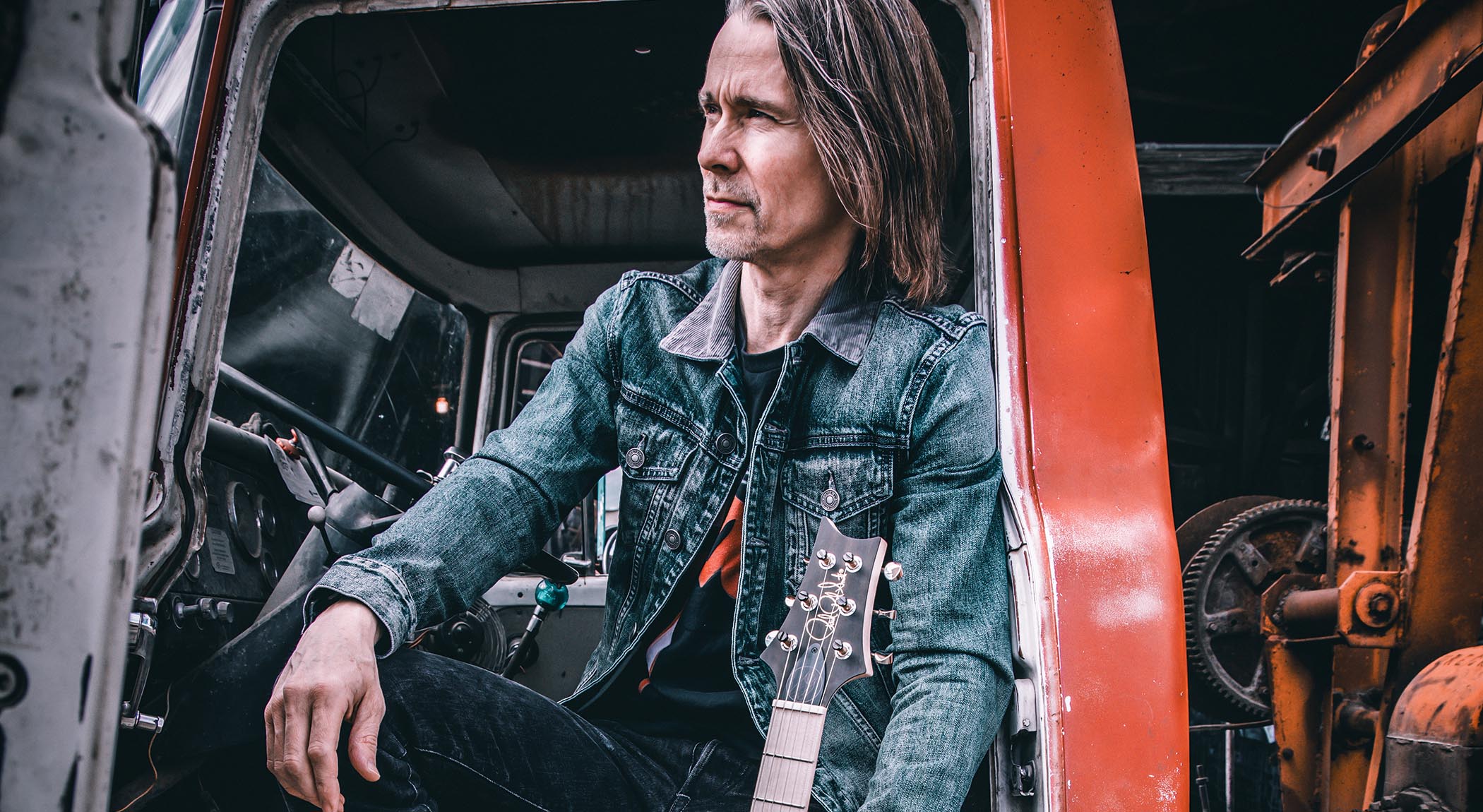“I don’t like brand-new guitars. I’ll see a new guitar and I’m like, ‘That’s gonna look good after I drag it across the driveway’”: Alter Bridge’s Myles Kennedy spills his tone (and drop tuning) secrets
Whatever you do, don’t lend Kennedy your brand-new 10 Top PRS, but do check out his new solo album, The Art of Letting Go, which he promises us is a “a rock ’n’ roll record – a lot of loud guitars”

Around autumn last year Myles Kennedy took time out from his regular gig as lead vocalist and guitarist with stadium rockers Alter Bridge. However, this was no holiday, neither was it to revisit his side project with Slash.
His aim was to record his third solo album – and this time he set his sights on recording a riff-heavy, no-holds-barred rocker.
So, when we had the chance to settle down with the man himself and ask a few pointed questions, we leapt at the chance…
What was your goal for this album?
“Well, I knew I didn’t want to make another acoustic record, which was great six years ago and it fulfilled a long-standing urge. But with this one I wanted to get back to making something that was informed by the power of the riff, you know?
“But using blues scales, pentatonic scales and what-not as a vocabulary so that I didn’t go too far into metal territory, which is something that Alter Bridge tends to lean on more. I wanted to make a rock ’n’ roll record – a lot of loud guitars – and just do what I guess I’m known for. And it was good to get back and start swimming in that stream again.”
The album has the force and precision of contemporary rock but still the gutsy, instinctive feel of classic rock. How have you blended those elements so seamlessly?
Get The Pick Newsletter
All the latest guitar news, interviews, lessons, reviews, deals and more, direct to your inbox!
“It’s a delicate dance. I was raised on classic rock, so that’s always going to be in my DNA. But at the same time I still want to be contemporary. I don’t want to just regurgitate something that’s already been done better than I’m ever going to be able to do it. I want to try to take it and kind of put my own spin on it and bring it into this era.
“And there are a number of ways to do that, but one of the big components is the sound and that’s where I feel like ‘Elvis’, [aka] Michael Baskette, the producer, is very helpful. He understands; he has that same goal. He loves all the classic stuff and he loves those sonic hallmarks, but he also wants to bring it into the present.”
In what way does your solo work stand apart from your work with Alter Bridge?
“I mean, especially that this is more of a hard rock record, the lines were blurred a little more. With the ballad Eternal Lullaby… I actually brought that to Alter Bridge a few years ago. And what happened is we just had so many ballads. There’s only a finite amount of spots for ballads in that context, so we didn’t use it. I wanted to make sure it saw the light of day, so I felt like it was appropriate on this record.
“But that’s a great question, because it’s like when you’re using a similar formula, then where does it go? And a lot of it, for me, boils down to knowing the language I’m speaking, musically.
“Alter Bridge is more detuned, heavy chugging and the rhythms are different, the rhythms are straighter. Some of this stuff swings. I think that’s another big part of it; it’s got a pocket and a groove that we just don’t explore with Alter Bridge.”

There’s an amazing solo on the track Say What You Will. How did you record that?
I’m going to tell you the secret sauce because everyone should have one of these pedals. It’s called [a Mythos] Argo... Get the Argo pedal, kids!
“What I want to do most of the time on records [is] improvise, but I hurt my hand. I always forget what it’s called, it involves my ulnar nerve. It’s a long story. So I wanted to make sure when I went in to record these solos, I kind of had a roadmap. I would improvise a few days before and then just piece together the parts I liked.
“No different from what I would do in the studio, but I basically have a rough sketch of what I’m going to do, so I don’t have to wear my hand down as much. And, if I remember correctly, we just knocked it out, just did a few takes and put it together, and we were off to the races.”
There’s also an interesting octave fuzz pedal on the intro. What effect were you using there?
“Yeah, that’s the secret sauce, right there. But I’m going to tell you the secret sauce because everyone should have one of these pedals. It’s called [a Mythos] Argo and I found it at Chicago Music Exchange.
“I went in there and I was like, ‘I need a really good fuzz…’ And so they had this pedal there, the Argo pedal. I’ve been asked that question by other guitar players, it’s such a great pedal. Get the Argo pedal, kids!”
The wonderful thing that you get from vintage gear is that mojo. But with this, I just kept it simple and used basically what I’m going to use live
What were your go-to electric guitars and amps for this record?
“My go-to were my signature [PRS] guitars, fresh out of the box. I had a few in boxes and I took them out, strung them up and that was it. Most of the record was done on this one black signature guitar, and it didn’t have a scratch on it when we took it out of the box, but by the time we finished the record, [it had] plenty of dings.
“I [also] had a green one that was kind of a prototype, which I used on some of the altered tunings. But other than that it’s that black signature guitar, straight into my Diezel Paul amp.
“On the second solo record I had all this vintage gear: my ’58 Fender Deluxe and my ’58 335, and the wonderful thing that you get from vintage gear is that mojo. But with this, I just kept it simple and used basically what I’m going to use live.”
So you’re quite a physical player, if the guitar ended up with loads of dings?
“I don’t like brand-new guitars. I don’t like it when they’re all shiny. I’ll see a new guitar and I’m like, ‘That’s gonna look good after I drag it across the driveway.’”
You spoke earlier about using drop tunings. How low did you go?
“I think the lowest I allowed myself to go was C on two tracks. I used it on a song called Miss You When You’re Gone. It was CGCGC and then the top string was a D.
“There’s a song called Dead To Rights and that’s basically open G tuning, but you tune the thickest string down to C, which is kind of interesting. So when you have that open G tuning, you think that that string should be a D, but when you tune it to a C it creates a whole different set of inspiration.”

Are you a prolific, rapid writer or do you tend to take a long time to write songs?
“It really depends on the track. Sometimes the universe will just drop something into your lap. I’m pretty prolific at starting things. Like, if you said, ‘I want you to sit down this afternoon and I want you to put together three songs,’ I’d probably be able to do that.
“But the problem is, I have an editing system that I like to use in terms of distance. So if I come up with something, I like to get away from it. I don’t want to finish it on the spot because I want to make sure that all the parts are up to par with the other parts.
“So it’s like, ‘Oh, that’s a great verse.’ And then you get to the chorus, and it’s like, ‘You can do better. You should search for a different chorus.’ So that’s where the time comes in. I need to step away.”
You’re going to take this album on tour shortly. What will your live rig look like?
“The same as what was in the studio. It will be the Argo pedal and I have a [J. Rockett] Chicken Soup [overdrive] pedal and a handful other little accoutrements. But that Diezel Paul amp into the Diezel 2x12 cabinet with the [Celestion] Creambacks, my PRS signature guitars and that’s it. Pretty simple.”
Are you looking forward to touring the new album?
“I count the days, yeah. I mean, once this press run is over, I’m going to be at home, just woodshedding and every day running the songs over and over. Because we’re going out as a three-piece, that’s a lot of pressure, in a good way. And I like that. I like the challenge. But it means I’m gonna have to get all these songs to where they’re just second nature. I’m just gonna rehearse and rehearse and rehearse.”
You’re singing as well, so there’s nowhere to hide…
“No, there’s nowhere to hide! And I’m cursing myself with some of the songs because I wrote the riffs a certain way, thinking, ‘Oh, it’s just going to be a guitar riff here.’
“But then we got in the studio and I listened back to the playback and I was like, ‘That needs a vocal part right here.’ And then you’re like, ‘I’ll figure it out…’ Now I’m cursing myself: ‘Why didn’t you just sing the guitar riff or something? But no, you had to do something different. Damn you, Kennedy!’”
- The Art of Letting Go is out now via Napalm.
With over 30 years’ experience writing for guitar magazines, including at one time occupying the role of editor for Guitarist and Guitar Techniques, David is also the best-selling author of a number of guitar books for Sanctuary Publishing, Music Sales, Mel Bay and Hal Leonard. As a player he has performed with blues sax legend Dick Heckstall-Smith, played rock ’n’ roll in Marty Wilde’s band, duetted with Martin Taylor and taken part in charity gigs backing Gary Moore, Bernie Marsden and Robbie McIntosh, among others. An avid composer of acoustic guitar instrumentals, he has released two acclaimed albums, Nocturnal and Arboretum.
“Even the thought that Clapton might have seen a few seconds of my video feels surreal. But I’m truly honored”: Eric Clapton names Japanese neo-soul guitarist as one to watch
“You better be ready to prove it’s something you can do”: Giacomo Turra got exposed – but real guitar virtuosos are being wrongly accused of fakery, too

















